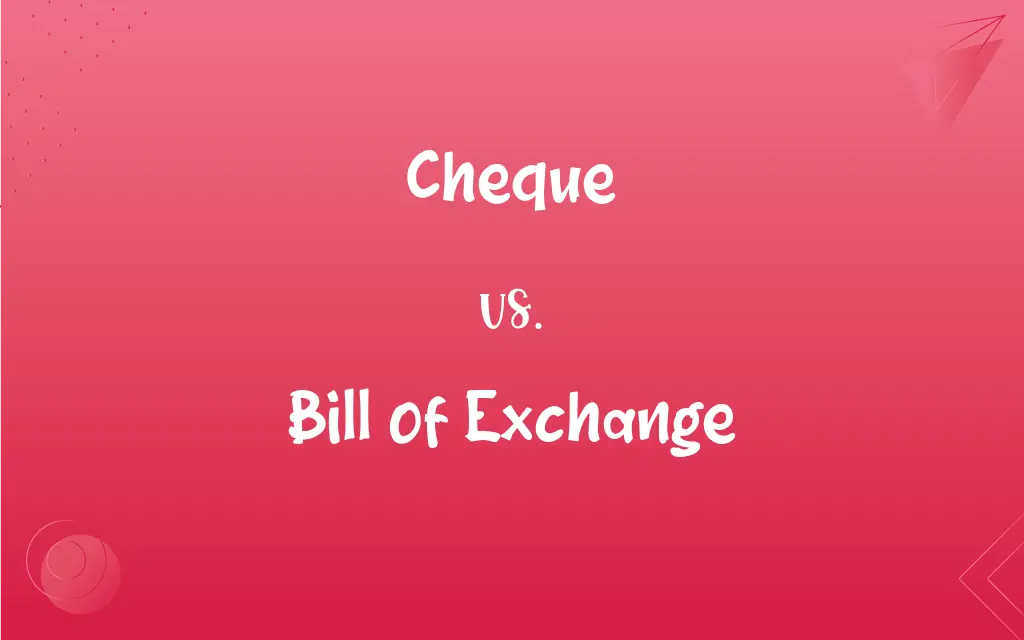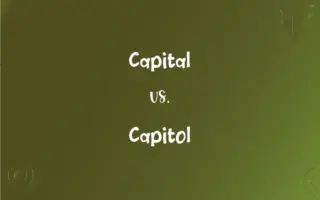Cheque vs. Bill of Exchange: What's the Difference?
Edited by Janet White || By Harlon Moss || Updated on October 20, 2023
A cheque is an order by an account holder to their bank to pay a specific amount, while a bill of exchange is an order by one party for another to pay a third party.

Key Differences
A cheque is a financial instrument that directs a bank to pay a specified sum of money from the drawer's account to a specified recipient. A bill of exchange, on the other hand, is an unconditional written order that binds one party to pay a certain sum to another party either immediately or at a future date. Both instruments play a pivotal role in the world of trade and finance.
The main difference between a cheque and a bill of exchange is the parties involved. In the case of a cheque, there are three parties - the drawer (who writes the cheque), the payee (to whom the payment is to be made), and the drawee (the bank). In contrast, the bill of exchange involves three distinct roles: the drawer (who creates the bill), the drawee (who is expected to pay), and the payee (who receives the payment).
Another point of distinction lies in their nature and usage. A cheque is always drawn on a bank, meaning it's the bank that will pay the amount. A bill of exchange, however, can be drawn on any individual or institution. It's a more flexible instrument in this regard.
A cheque has a more immediate connotation, often requiring payment on demand. On the contrary, a bill of exchange can be payable either on demand or at a specific future date. This offers greater flexibility in terms of payment schedules.
While a cheque can only be dishonored due to insufficient funds in the drawer's account, a bill of exchange can be dishonored for other reasons too, such as non-acceptance by the drawee.
ADVERTISEMENT
Comparison Chart
Nature
Directs a bank to pay a specified sum.
Unconditional order to pay a specified sum.
Parties involved
Drawer, payee, drawee (bank).
Drawer, drawee, payee.
Drawn On
Always drawn on a bank.
Can be drawn on any individual or entity.
Payment
Typically on demand.
Either on demand or at a future date.
Reasons for dishonoring
Mostly due to insufficient funds.
Can be due to non-acceptance or other reasons.
ADVERTISEMENT
Cheque and Bill of Exchange Definitions
Cheque
A cheque represents a promise of payment by the drawer's bank.
The cheque bounced due to insufficient funds in the account.
Bill of Exchange
A bill of exchange is commonly used in international trade.
The exporter sent a bill of exchange along with the shipment documents.
Cheque
A cheque contains details like amount, date, and payee.
The cheque was post-dated for next month.
Bill of Exchange
A bill of exchange can be payable on demand or at a specified future date.
The bill of exchange was set to mature in 90 days.
Cheque
A cheque is a negotiable instrument for transferring funds.
He deposited the cheque he received as a birthday gift.
Bill of Exchange
A bill of exchange involves three parties: drawer, drawee, and payee.
The drawer issued a bill of exchange, which the drawee accepted.
Cheque
A cheque is a written order directing a bank to pay money.
She wrote a cheque for $100 to pay for groceries.
Bill of Exchange
A bill of exchange is a legally binding document.
Upon non-acceptance, the bill of exchange was returned to the drawer.
Cheque
A cheque can either be bearer or order-based.
He lost a bearer cheque, which means anyone could cash it.
Bill of Exchange
A bill of exchange is a written order to pay a fixed amount of money.
He settled his debt using a bill of exchange.
Cheque
Variant of check.
FAQs
What happens if a cheque bounces?
If a cheque bounces, it means the bank did not honor it, often due to insufficient funds in the drawer's account.
What is a cheque?
A cheque is a written order directing a bank to pay a specified sum from the drawer's account to a designated recipient.
Can a cheque be made payable to "cash"?
Yes, a cheque made payable to "cash" can be cashed by anyone holding the cheque.
When is a bill of exchange said to be "accepted"?
A bill of exchange is "accepted" when the drawee acknowledges and agrees to pay the sum mentioned in it.
What is a crossed cheque?
A crossed cheque has two parallel lines on its face, indicating it can only be deposited directly into a bank account, not cashed outright.
Why is a bill of exchange essential in international trade?
A bill of exchange provides a documented commitment to pay, establishing trust between trading parties across borders.
How is the maturity of a bill of exchange determined?
The maturity of a bill of exchange can be either on demand or at a specified future date as mentioned on the bill.
Can a cheque be post-dated?
Yes, a cheque can be post-dated, meaning it's dated for a future time and cannot be cashed until that date.
Who are the parties involved in a bill of exchange?
The three main parties in a bill of exchange are the drawer, the drawee, and the payee.
Who bears the risk if a bearer cheque is lost?
If a bearer cheque is lost, the risk is generally borne by the holder since anyone who finds it can cash it.
Can cheques be electronic?
Yes, electronic cheques or e-cheques are digital versions of traditional paper cheques.
Can a cheque be canceled after issuing?
Yes, a cheque can be "stopped" or canceled by the drawer before it is cashed.
What is the difference between a bearer and an order cheque?
A bearer cheque can be cashed by anyone holding it, while an order cheque is payable only to the specified person named on it.
Is a bill of exchange negotiable?
Yes, a bill of exchange is a negotiable instrument, meaning its ownership can be transferred from one person to another.
What happens if a bill of exchange is dishonored?
If a bill of exchange is dishonored, it means the drawee refuses to accept or pay it, resulting in legal implications for involved parties.
Can a bill of exchange be endorsed?
Yes, a bill of exchange can be endorsed, transferring the right to receive payment to another party.
How does a bill of exchange function?
A bill of exchange is an unconditional order by one party directing another party to pay a fixed amount either immediately or on a specified date.
How does a bill of exchange facilitate trade?
A bill of exchange ensures a documented commitment to pay, providing security and trust in trade transactions.
What details are mandatory on a cheque?
Essential details on a cheque include the date, payee's name, amount in words and figures, and the drawer's signature.
Can a bill of exchange be renewed?
Yes, with mutual agreement between parties, a bill of exchange can be renewed or extended.
About Author
Written by
Harlon MossHarlon is a seasoned quality moderator and accomplished content writer for Difference Wiki. An alumnus of the prestigious University of California, he earned his degree in Computer Science. Leveraging his academic background, Harlon brings a meticulous and informed perspective to his work, ensuring content accuracy and excellence.
Edited by
Janet WhiteJanet White has been an esteemed writer and blogger for Difference Wiki. Holding a Master's degree in Science and Medical Journalism from the prestigious Boston University, she has consistently demonstrated her expertise and passion for her field. When she's not immersed in her work, Janet relishes her time exercising, delving into a good book, and cherishing moments with friends and family.































































